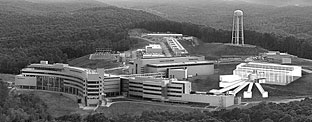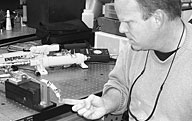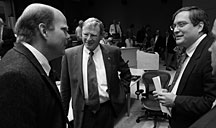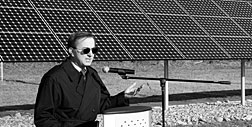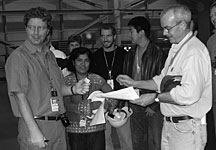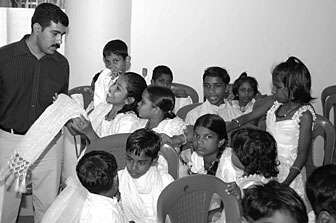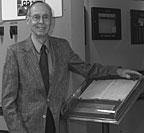 |
Number 107, January–February 2009 |
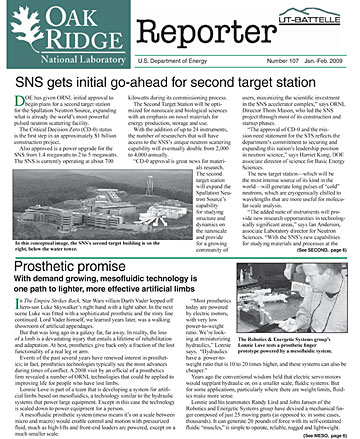 |
|
| Lab marks campus ‘commitment to sustainability’ |
|
| Lab Notes | |
|
|
|
|
|
|
| ‘Counsel of despair’ | |
| New Staff Members | |
| Rudakov latest Wigner | |
| Club ORNL | |
| Three Lab researchers remembered | |
| ORNL veteran Don Trauger dies |
 SNS gets initial go-ahead for second target station
SNS gets initial go-ahead for second target station
|
|
In this conceptual image, the SNS’s second target building is on the right, below the water tower. |
DOE has given ORNL initial approval to begin plans for a second target station for the Spallation Neutron Source, expanding what is already the world’s most powerful pulsed neutron scattering facility.
The Critical Decision Zero (CD-0) status is the first step in an approximately $1 billion construction project.
Also approved is a power upgrade for the SNS from 1.4 megawatts to 2 to 5 megawatts. The SNS is currently operating at about 700 kilowatts during its commissioning process.
The Second Target Station will be optimized for nanoscale and biological sciences with an emphasis on novel materials for energy production, storage and use.
With the addition of up to 24 instruments, the number of researchers that will have access to the SNS’s unique neutron scattering capability will eventually double from 2,000 to 4,000 annually.
“CD-0 approval is great news for materials research. The second target station will expand the Spallation Neutron Source’s capability for studying structure and dynamics on the nanoscale and provide for a growing community of users, maximizing the scientific investment in the SNS accelerator complex,” says ORNL Director Thom Mason, who led the SNS project through most of its construction and startup phases.
“The approval of CD-0 and the mission need statement for the STS reflects the department’s commitment to securing and expanding this nation’s leadership position in neutron science,” says Harriet Kung, DOE associate director of science for Basic Energy Sciences.
The new target station—which will be the most intense source of its kind in the world—will generate long pulses of “cold” neutrons, which are cryogenically chilled to wavelengths that are more useful for molecular-scale analysis.
“The added suite of instruments will provide new research opportunities in technologically significant areas,” says Ian Anderson, associate Laboratory director for Neutron Sciences. “With the SNS’s new capabilities for studying materials and processes at the micro- and nanoscale, researchers will have the tools to develop new materials for a broad range of applications including advanced automotive battery technology, new steel alloys and pharmaceuticals.”
Research at the first target station at SNS, which has 10 instruments either operating or in commissioning, has already provided new insight into the behavior of materials used for the efficient transmission of electricity and has facilitated the development of new methods of administering medicines.
As home of the SNS and the recently upgraded High Flux Isotope Reactor, ORNL is the world’s leading center for neutron
science.
CD-0 is the first of five “critical decisions” that govern construction of DOE facilities and projects and is required before the development of a conceptual design study and submission of a budget request for the start of project engineering and design efforts.
The project completion is estimated for 2020.—B.C. ![]()
 Prosthetic promise
Prosthetic promise
With demand growing, mesofluidic technology is one path to lighter, more effective artificial limbs
|
The Robotics & Energetic Systems group’s Lonnie Love tests a prosthetic finger prototype powered by a mesofluidic system. |
In The Empire Strikes Back, Star Wars villain Darth Vader lopped off hero-son Luke Skywalker’s right hand with a light saber. In the next scene Luke was fitted with a sophisticated prosthetic and the story line continued. Lord Vader himself, we learned years later, was a walking showroom of artificial appendages.
But that was long ago in a galaxy far, far away. In reality, the loss of a limb is a devastating injury that entails a lifetime of rehabilitation and adaptation. At best, prosthetics give back only a fraction of the lost functionality of a real leg or arm.
Events of the past several years have renewed interest in prosthetics; in fact, prosthetics technologies typically see the most advances during times of conflict. A 2008 visit by an official of a prosthetics firm revealed a number of ORNL technologies that could be applied to improving life for people who have lost limbs.
Lonnie Love is part of a team that is developing a system for artificial limbs based on mesofluidics, a technology similar to the hydraulic systems that power large equipment. Except in this case the technology is scaled down to power equipment for a person.
A mesofluidic prosthetic system (meso means it’s on a scale between micro and macro) would enable control and motion with pressurized fluid, much as high-lifts and front-end loaders are powered, except on a much smaller scale.
“Most prosthetics today are powered by electric motors, with very low power-to-weight ratio. We’re looking at miniaturizing hydraulics,” Lonnie says. “Hydraulics have a power-to-weight ratio that is 10 to 20 times higher, and these systems can also be cheaper.”
Years ago the conventional wisdom held that electric servo motors would supplant hydraulic or, on a smaller scale, fluidic systems. But for some applications, particularly where there are weight limits, fluidics make more sense.
Lonnie and his teammates Randy Lind and John Jansen of the Robotics and Energetic Systems group have devised a mechanical finger composed of just 25 moving parts (as opposed to, in some cases, thousands). It can generate 20 pounds of force with its self-contained fluidic “muscles,” is simple to operate, reliable, rugged and lightweight.
“The key is the control valves,” Lonnie says. “Hydraulic force is proportional to pressure--2,000 pounds per square inch is a lot of force. The flow rate of the fluid controls velocity, and the control valve controls how much fluid goes to the artificial joint’s actuator, or muscle.”
The Measurement Science & Systems Engineering Division group has designed tiny valves that provide a crucial combination of high pressure at low flow to mimic the operation of a true muscle. The prototype system works with simple mineral oil, channeled through a two-thousandths of an inch diameter valve port.
|
Lonnie Love (left) talks with Sen. James Inhofe (center) and Orthocare’s David Boone at a 2008 Oklahoma tech transfer symposium. |
“There are lots of low-flow, low-pressure systems and high-flow, high-pressure systems, but combining high pressure and low flow is the key to making artificial hands and feet that work similar to the real limbs,”
Lonnie says. “These valves are the keys to making controllable hands and feet.”
Recently Doug McCormack, chief executive officer of the prosthetic firm OrthoCare Innovations, visited ORNL accompanied by the company’s chief technical officer, David Boone. They received tours and briefings on ORNL technologies and capabilities that could be applied to advanced prosthetics, such as superhydrophobic materials, carbon foam, e-beam curing and low-cost manufacturable titanium.
“By the end of the day they felt like they were in a grocery story,” Lonnie says.
McCormack, whose company’s headquarters is in Washington, D.C., is trying to overcome the cyclical nature of prosthetics research funding, which spikes during wartime and ebbs when injuries subside in peace. His relationships with lawmakers are bolstered by the fact that he, himself, wears a prosthetic leg.
The company is attempting to establish a research center in Oklahoma City, where OrthoCare Innovations has a manufacturing facility. Lonnie, Art Clemons and others recently participated in a technology showcase there, also attended by Sen. James Inhofe, a congressional supporter of prosthetics research.
Lonnie believes prosthetics technologies, which haven’t seen a great deal of advancement since the 1970s, are poised to benefit from materials and systems technology advances of the past few decades.
“They [OrthoCare] sent me prosthetic parts and asked what we could do. Half the weight on a prosthetic foot is only the metal fasteners. Cliff Eberle is working on a high-strength composite made with e-beam curing. You could make everything out of composites with tremendous weight savings,” Lonnie says.
Blunt-force trauma injuries from current conflicts have bumped up the demand for new and better artificial limbs. |
Other ORNL materials that apply to better prosthetics include carbon foam, whose heat transferring properties could make wearing artificial limbs more comfortable, as would the superhydrophobic material, which could alleviate the discomfort caused by perspiration at prosthetic-limb interfaces. ORNL’s new low-cost method for casting titanium could have a major lightweight benefit. OrthoCare also asked if parts could be coated in nickel, which makes them resistant to infection.
ORNL-developed materials may soon be joined with Defense Advanced Research Projects Agency-funded control systems. One is nerve reinnervation, being developed by Dr. Todd Kuiken of the Rehabilitation Institute of Chicago, who attached the arm nerves of a Dayton, Tenn., double amputee, Jessee Sullivan, to healthy chest muscles. Sullivan has learned to move his prosthetic arms by simply “thinking” about what he wants them to do.
Other approaches to prosthetic control are implanting “bions,” or electronic capsules, in the nerves of lost limbs, which would work with a cuff at the interface with the prosthetic and brain-machine interfaces that would transmit brain activity to the limbs.
“Quadriplegics could really benefit from this,” Lonnie says, describing fluidic-based systems that would help power enfeebled limbs. “It’s far out, but there is lots of potential.”
That potential is being recognized by the National Science Foundation and DARPA, who are active in advancing the state of the art in prosthetics. Advances in hydraulic and fluidic technologies stalled after a spurt of advances in electric motors occurred.
“The best books on hydraulics were written in the ’50s, ’60s and ’70s,” says Lonnie, who recalls that his Georgia Tech mentor was dubious about his choice of hydraulics as a specialty. Funding at the time was nearly nonexistent. Now, however, that same professor is the first Distinguished Chair in Fluid Power at Georgia Tech.”
Combat injuries from current conflicts, which have been dominated by blunt-force trauma, have bumped up the demand for new and better artificial limbs.
One new technology that is not so “far out” is a mesofluidic alignment device that would help patients properly align their prosthetic legs with the residual limb, which is typically a difficult procedure requiring multiple refits.
To someone like OrthoCare’s McCormack, who has experienced the challenges presented by the loss of a limb, ORNL is a font of promise directed toward improving shattered lives and moving advanced prosthetics out of space-operas and into reality.
“He was absolutely giddy when he left,” Lonnie says of McCormack’s visit. “His excitement is something I’ll never forget.”
—B.C. ![]()
 Lab marks campus ‘commitment to sustainability’
Lab marks campus ‘commitment to sustainability’
|
As evidenced by ALD Dana Christensen’s sunglasses, the weather was appropriately bright and sunny for the January 22 dedication of the Lab’s solar array. |
ORNL’s thrust toward a “sustainable” campus and the individual role of staff members in conserving energy were focal points of January 22’s Energy Awareness
Celebration.
The event, part of the Lab’s developing Sustainable Campus Initiative and the energy saving performance contract with Johnson Controls, Inc., rolled out the Sustainable Energy Education & Communications, or SEEC, program, a series of 10 Web-based learning modules (one a month) that will explain how energy efficiency and renewable energy practices result in a more sustainable society. A “sustainable society” is defined as one that is able to support and build on its standard of living while providing options for the future through smart energy practices.
“This initiative is part of our commitment to sustainability in our own operations—our energy footprint and the way we generate energy and the way we use it, or hopefully in some cases, not use it,” says Lab Director Thom Mason.
The day’s activities kicked off with the dedication of the solar array on Bethel Valley Road. The nearly 100-yard-long, 10-footwide solar collectors generate a little over 50 kilowatts at peak power, or enough juice to power 40 percent of nearby Building 3147, which has an Energy Star rating.
The power is actually being sent to the electric grid, explained Energy & Engineering Sciences ALD Dana Christensen. “It is an element of turning an office building into a zero-energy commercial building,” Dana said.
The Johnson Controls-sponsored SEEC event also featured giveaways, including a compact fluorescent light bulb, and door prizes including an assortment of solar-powered battery chargers.
The SEEC learning modules, which begin next month, come in monthly installments that explain different facets of sustainability and how they relate to ORNL and to society. Topics include sustainability, energy efficiency, lighting systems, water resources, indoor environments, recycling, climate change and buying “green.”
ORNL and Johnson Controls are partnering on the TEAM Initiative encompassing major projects such as the Lab’s steam plant upgrade, which will feature a biomass-fueled boiler serving the main campus and a state-of-the-art Cleaver Brook super boiler for Melton Valley facilities.
The steam plant upgrade is projected to reduce the operation’s fossil fuel consumption by 80 percent.
“The Lab will save about $8.7 million a year in energy costs, and those savings will be used to pay back the $89 million that Johnson Controls has put into the project,” says F&O Deputy Director Jimmy Stone.
Other aspects of the sustainability initiative include ORNL’s new fleet of “Bike It Green” bicycles and 11 electric vehicles. ORNL also plans to eventually build a parking lot equipped with solar chargers for plug-in hybrid vehicles.—B.C. ![]()
 AAAS, APS recognize Lab researchers as society fellows
AAAS, APS recognize Lab researchers as society fellows
Eight ORNL researchers were recently
named fellows of two leading professional societies.
Rebecca Efroymson and Paul Hanson, both of the Environmental Sciences Division, have been elected fellows of the American Association for the Advancement of Science, the world’s largest general scientific society.
Rebecca was recognized for her important contributions to the science and practice of ecological risk assessment. Paul was cited for his contributions to research on carbon cycling in terrestrial ecosystems and scientific leadership in the field of forest response to environmental change.
This year’s newly elected fellows of the American Physical Society include six ORNL research scientists.
Chong Long Fu of the Materials S&T Division was recognized for his contributions to the fundamental understanding of the electronic, magnetic and structural properties of metallic and intermetallic systems based on accurate first-principles calculations.
Corporate Fellow Amit Goyal of the Materials S&T Division was recognized for his pioneering work with high-performance, high-temperature superconducting wires. His research has resulted in more than 50 issued patents and has had a significant impact on the commercial industry.
The society cited the Physics Division’s Randy Vane for his “elegant experimental elucidation of charge transfer and other fundamental inelastic processes in atomic, molecular and bulk matter systems.”
Soren Sorensen, also of the Physics Division, was cited for his important contributions to the field of relativistic heavy ion collisions, in particular for systematic studies of stopping and transverse energy production.
The Neutron Scattering Science Division’s Andrey Zheludev was nominated for his elegant neutron scattering investigations of quantum magnetism and quantum critical phenomena, especially in spin-chain compounds.
Pengcheng Dai, also of the Neutron Scattering Science Division, was recognized for his contributions to understanding fundamental properties of magnetic excitations in high-temperature superconductors, f-electron heavy Fermions, and colossal magneto-resistance manganites.
Both Soren Sorensen and Pengcheng Dai hold joint appointments with the University of Tennessee.—Sarah Wright ![]()
 |
 Flaws in nanotubes key to circuits
Flaws in nanotubes key to circuits
A recent article by a team led by the Computer Science & Mathematics Division’s Vincent Meunier theorizes that structural defects introduced into carbon nanotubes could lead the way to carbon nanotube circuits.
Individual carbon nanotubes are excellent conductors of electricity, but that conductivity goes away when they are connected together into circuits because the junctions act as barriers. In fact, the connections are effective insulators.
However, simulations by Vincent, working in the Center for Nanophase Materials Sciences, and collaborators at Mexico’s National Laboratory for Nanoscience and Nanotechnology Research show that imperfections in the carbon lattice structure, which is typically hexagonal, improves conductivity between nanotubes.
The finding, says New Scientist magazine, could lead to nanoscale circuits that enable, for example, more compact and more powerful computers, made of carbon nanotube materials that outperform silicon.
The article is published in the journal ACS Nano.
 New: STEM of whole cells in liquid
New: STEM of whole cells in liquid
Researchers at ORNL and Vanderbilt University have unveiled a new technique for imaging whole cells in liquid using a scanning transmission electron microscope. The work was recently described in the online Proceedings of the National Academy of
Sciences.
“Electron microscopy is the most important tool for imaging objects at the nano-scale—the size of molecules and objects in cells,” says Niels de Jonge of the Materials S&T Division. “But electron microscopy requires a high vacuum, which has prevented imaging of samples in liquid, such as biological cells.”
The new technique – liquid STEM – uses a micro-fluidic device with electron-transparent windows to enable the imaging of cells in liquid. Niels’ team imaged individual molecules in a cell, with significantly improved resolution and speed compared with existing imaging methods.
“Liquid STEM has the potential to become a versatile tool for imaging cellular processes on the nanometer scale,” says Niels. “It will potentially be of great relevance for the development of molecular probes and for the understanding of the interaction of viruses with cells.”
Team members also include David W. Piston of Vanderbilt University Medical School and postdocs Diane Peckys of ORNL and UT and GertJan Kremers of VUMS.
The technique will also become a resource for energy science, as researchers use it to visualize processes that occur at liquid-solid interfaces.
 Instruments: Watch’em grow
Instruments: Watch’em grow
|
Lead instrument scientist Jason Hodge holds the key to the POWGEN beam line shutter at December’s first neutrons. |
Shortly before the CD-0 go-ahead on the Spallation Neutron Source’s second target was announced, the Neutron Sciences Directorate experienced a growth spurt in instruments starting their commissioning process.
The SNS’s Powder Diffractometer, or POWGEN, was completed just before the holidays. Designed for the study of polycrystalline materials, POWGEN will offer users greater flexibility and higher precision than most existing similar machines.
The High Flux Isotope Reactor’s refurbished Powder Diffractometer, which is used for crystal and magnetic structural studies, also began its commissioning process in late December, as did the SNS Extended Q-Range Small-Angle Neutron Scattering Diffractometer, or EQ-SANS. Initial data indicate that the EQ-SANS will meet or exceed its design goals, opening new opportunities for studies in life science, materials research and earth and environmental sciences. Everyday applications include improved polymers; better detergents, soaps, and similar materials; more effective drugs from protein studies; and improved materials for the oil industry.
The SNS also expects permission to proceed soon on three more instruments: the Macromolecular Neutron Diffractometer, or MaNDi; the Elastic Diffuse Scattering Spectrometer, or CORRELLI; and the Chemical Spectrometer, or VISION.
 Charity at home and abroad
Charity at home and abroad
The outpouring of sympathy and monetary donations from ORNL in the aftermath of the late-2004 Asian tsunami saw its fruition in December, far away in India.
The Divine Children’s Home in Trivandrum, India, opened in December, providing shelter to 60 needy children. The home received $100,000 from UT-Battelle, which matched a similar amount donated by Lab staff members for tsunami relief.
|
Backstage at the dedication of the Divine Children’s Home in Trivandrum, India. Now they have a nice place to stay. |
The new facility can house twice as many children as the former lodging.
“Divine Children’s Home has always been a warm sanctuary for the needy children of Trivandrum,” says the home’s director, Alice Thomas. “Thanks to UT-Battelle and other benefactors, the dream to operate out of our own premises has become a reality.”
Closer to home, UT-Battelle stepped up when fire destroyed a log cabin at Norris Elementary School that was serving as the school’s science center. The building, which had just opened a few weeks earlier, was insured. UT-Battelle chipped in the $500 deductible.
Lab employees have also helped out colleagues Ron and Krystee Conaway, whose Loudon County home burned just before Christmas. Krystee says she and Ron have been “greatly comforted by the concern of fellow co-workers.”
Reported by Bill Cabage and Sarah Wright |
 ‘Counsel of despair’
‘Counsel of despair’
In A-bomb aftermath, Clinton Lab managers were adamant on civilian control
ORNL’s History Room has a standing invitation to retired or retiring Lab researchers: If you don’t have a home for your papers, the History Room volunteers will take a look at them.
Every once in a while a jewel turns up.
That’s what has happened in the case of the late Ellison Taylor, the Lab chemist and manager who died last year. A box of his papers contained a document that might have helped establish the cornerstone of how the United States manages its nuclear technology, including its arsenal.
It is a carbon copy, signed in ink by 15 Clinton Laboratories managers, of a 1946 letter to Sen. Brien McMahon urging that atomic energy development be placed under civilian control.
|
The papers of the late Ellison Taylor (right) contained a copy of a letter to Sen. Brien McMahon (left), who chaired the special committee on atomic energy in 1946. |
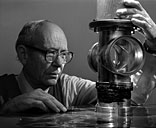 |
In fact, the tone of the letter suggests their experiences under military supervision for the preceding four years of the Manhattan Project left them with strong feelings— mostly negative—about the “Army way” and the prospect of a nuclear age under military control.
“The advocates of such a policy are doubtlessly motivated by the desire to safeguard the security of the nation. To us, who developed atomic energy, who worked under military rule, who have thought for years about this problem, it is all too clear that military control would achieve exactly the opposite—that it would increase immeasurably the very dangers that we wish to avoid,” says the letter, dated March 18, 1946.
A nationwide “scientists movement” sprang up in 1945 to address concerns that the then-War Department was attempting to codify its dominant role over nuclear R&D.
McMahon at the time was chairman of the senate’s special committee on atomic energy. He authored the Atomic Energy Act of 1946, also known as the McMahon Act. If the senator was trying to convince his colleagues about the wisdom of civilian control, the letter provided him with eloquent ammunition.
The letter also exhibits a sense of things to come, including the Cold War and the arms race:
“In the political field, any dominance by the army would announce to the world a lack of faith in a peaceful solution of the present world crisis. It would be considered as the opening gun for an atomic armamets race that can only end in disaster for civilization. (ital) We are not ready to accept this counsel of despair.”
The Clinton Laboratories managers (the Lab would take its current name a year later) gave the military credit for organizing the “gigantic industrial undertaking.” But they refuted the notion that only the military could safeguard the then-secret bomb technology, citing the “voluntary censorship” of researchers before the army became involved in atomic research.
They also faulted the Army for the compartmentalization of information, procrastination in transferring the technology to civilizian use and censorship by officials who had little grasp of facts or technology. It is plainly evident in the language of the letter that these gentlemen, along with others in the Manhattan Project, had gotten their bellies full of the military.
Their experiences under military supervision left them with strong feelings—mostly negative— about the prospect of a nuclear age under military control. |
Ellison Taylor’s possession of the carbon copy, which bears the ink signatures of all 15 signers, either is evidence of his authorship or of his recognition of the document’s significance. Bonnie Nestor, who writes for the Lab director’s office, says that Taylor possessed an impeccable style of prose, as did his colleague Alvin Weinberg and, likely, others in this erudite group.
Taylor arrived at the future ORNL in 1945 from Columbia University and directed the Chemistry Division from 1954 to 1974, while still continuing research.
The letter’s Clinton Laboratories signatories, essentially the directors of the chemistry and physics divisions and section chiefs, are
L.W. Nordheim, director, Physics Division
J.H. Coe, director, Chemistry Division
H.S. Brown, assistant director, Chemistry Division
A. Longacre, assistant director, Physics Division,
K.Z. Morgan, section chief, Health Physics Section
P.S. Henshaw, group leader, Biological Section
J.H. Snell, section chief, Physics Division
E.O. Wollan, section chief, Physics
Division
H.W. Newson, section chief, Physics
Division
L.B. Borst, section chief, Physics Division
A.M. Weinberg, section chief, Physics Division
E.H. Taylor, assistant to the director,
Chemistry Division
S.G. English, section chief, Chemistry Division
N. Elliott, section chief, Chemistry
Division
The list reads like an honor roll of ORNL history. Nordheim and Coe were storied scientists and administrators. Morgan was a leader in health physics research. Wollan discovered neutron scattering at the Graphite Reactor with another researcher, Clifford Shull, who lived to receive the Nobel Prize. Weinberg, of course, directed ORNL for nearly 20 years and became an internationally renowned authority on science policy and administration, coining the term Big Science.
McMahon’s legislation as eventually passed lacked the Vandenberg Amendment opposed in the letter’s last paragraph. President Truman signed the Atomic Energy Act of 1946 on August 1. Clinton Laboratories shipped the first radioisotopes for medical use the very next day, on August 2.
But the arms race genie was already out of the bottle. In 10 years the Soviet Union was also a nuclear power and the Cold War was in full swing. Nevertheless, the nation’s nuclear arsenal remains under civilian control.
Ellison Taylor died in Oak Ridge on May 31, 2008, at age 94. His copy of the letter now resides in Lab Records.
If you have documents you would like the History Room crew to examine, contact Debbie Dickerson, (865) 574-4160.—B.C. ![]()
The text of the letter from Clinton Laboratories managers to Sen. Brien McMahon.
Oak Ridge, Tennessee
The Honorable Brien McMahon Dear Senator McMahon: The undersigned represent research men who still occupy key positions at the laboratories of the Manhattan District. We have experienced war and peace times on the atomic energy project and it is on us that a large share of the responsibility for continuation of atomic energy developments have been placed. At this time when legislation on atomic energy is to be formulated by Congress, we are in conscience bound to bring into the open our fight against any attempts to reserve for the army a dominant role in the formulation of our national policies. The advocates of such a policy are doubtlessly motivated by the desire to safeguard the security of our nation. To us, who developed atomic energy, who worked under military rule, who have thought for years about this problem, it is all too clear that military control would achieve exactly the opposite—that it would increase immeasurably the very dangers that we wish to avoid. In the political field, any dominance by the army would announce to the world a lack of faith in a peaceful solution of the present world crisis. It would be considered as the opening gun for an atomic armaments race that can only end in disaster for civilization. We are not yet ready to accept this counsel of despair. But even if we concede, which we emphatically do not, that security lies in more and better bombs, we insist that army control is not the method to preserve such superiority. The army has not invented the atomic bomb. Like all the great technical contributions of the war, its development has been due to the vision of civilian scientists whose persistence overcame the inertia of the military system. Any military control of science would inevitably mean the retardation of further progress both in peace time and war time applications. The disintegration of the famed Los Alamos Laboratory, according to General Groves’ own statement, constitutes sufficient indication of army failure to comprehend the essentials of successful research. It has been argued that only the army can guard the “secret” of the atomic bomb. The completely successful voluntary censorship of the scientists at a time the army did not dream of atomic bombs demonstrates that military supervision is not a prerequisite for security of information where such security is needed. The delays produced by the army system of compartmentalization, denying the research men on the atomic energy project access to facts that are necessary for their work, the procrastination in releasing results of highest value to the medical and biological sciences though these results are of no military importance, show that it is only detrimental to place the power of censorship into the hands of persons who are in no position to judge the facts. During the war, the army alone had the power to commandeer the necessary resources and priorities for a gigantic industrial undertaking whose purpose could not be revealed. We recognize the great organizational feats that have been accomplished. However, this achievement in expediting successfully a definite assignment does not qualify the army for tasks that are not its proper function. We urge that any legislation passed by congress for the control of atomic energy be based on the cardinal principle of final absolute civilian determination of national policy, as in all other fields of government. The military’s legitimate place should be maintained as the instrument of and advisor on but not as the maker of policy. The Vandenberg amendment to the McMahon bill would create besides the civilian atomic energy commission a military board with an explicit directive to pass on (and to take initiative with regard to) any action, proposed action, or lack of action according to the boards own judgement, restricted only by final arbitration by the President. Such a measure will either result in dangerous confusion of authority or it will give the military board such influence over the decisions of the committee as is inconsistent with the foregoing principle. Therefore, we recommend that provision for the military liaison board be omitted from legislation passed for the control of atomic energy.
|
|---|
 New Staff
Members
New Staff
Members
New hires for December 2008
Steven Edward Hamblen, Dennis James Solley and James Edwin Wallace (transfer), NScD Neutron Facilities Dev.
Mark Benjamin Keck (transfer) and Brian Wilson, Business & Info. Services Dir.
Roy Travis Breeden, Facilities Development
Cassandra Nicole Huggins, NScD Research Reactors
David Jerone Russell, Campus Support & Instrumentation
John Timothy Watkins, Laboratory Protection
Priscilla Silvestry Witmer, National Security Directorate (re-hire)
Jerry Charles Coleman, Utilities
Jennifer Lynette Moss, NScD Research Acc.Ronald Dean Mulig and Slade Eugene Griffin, Information Technology Services
Steven Keith Peterson, and Thomas Michael Blair, Computational Sciences & Eng.
German Dmitriyevich Samolyuk, Materials S&T
Sandra Ellis Schmidt, Nonreactor Nuclear Facilities
Brian Keith Arlington, Office of Chief Information Officer
Charles Eric Mulkey, Environ. Prot. & Waste Svs (re-instatement)
Dyrk Brent Greenhalgh, Global Nuclear Security Tech.
Sebron Shipley Coleman III, Fac. Mgmt.
Gregory Scott Jones, Communications & External Relations Dir.
Denise Lynn Schuh, Nuclear S&T
James Andrew Simmons, Center for Computational Sciences
New hires for January 2009
Richard Alex Franco, Environmental Protection & Waste Svs
Joshua Adam Greene, Fabrication, Hoisting & Rigging
Chris Sebastian Groer, Computer Science & Mathematics
Genera C. Johnson, Lab. Protection (re-hire)
Timothy J. LaClair, Energy & Transportation Science
Joshua Samuel Ladd and Arthur Bernanrd Maccabe, Computer Science & Math.Ricky David Short (re-hire) and
Roger Lee Childs, Information Technology Services
Justin Matthew Beaver, Computational Sciences & Engineering
Steven A. Fisher, Global Initiatives Dir.
Amit Shyam, Materials Science and Technology
Russell Dale Henderson, Laboratory Protection (re-instatement)
Nathan Carl Rowe and Katrina Kidd Skompski, Global Nuclear Security Tech.
Christopher Ray Abernathy, Environmental Sciences
Letha Renee Evans, Audit & Oversight Dir.
Henry Daniel Kuehn, Center for Computational Sciences
 Rudakov latest Wigner
Rudakov latest Wigner
|
Rudakov |
Fedor Rudakov has joined the Computer Science & Mathematics Division as a Wigner Fellow working with Yehuda Braiman.
Fedor received his master’s degree in physical chemistry from Moscow State University in 2002 and a doctorate from Brown University in 2008. He has received several university fellowships and has 10 publications.
Fedor’s prime research interests involve ultrafast laser spectroscopy and electron diffraction. At ORNL his research will concentrate on developing novel methodologies for detection and sensing using laser spectroscopy.
 Club ORNL
Club ORNL
|
Get the details and latest news on Club ORNL online via the ORNL home page and on ORNL Today. Retirees, to gain access to the ORNL home page, first register in XCAMS by going to http://www.ornl.gov/adm/clubornl_signup.shtml. After receiving your XCAMS account and Club ORNL membership, retirees can then go directly to https://www.ornl.gov/adm/clubornl. Ross Toedte, 574-1912, toedterj@ornl.gov, is the retiree point of contact.
Retiree news: CORRE elects officers The board of directors of the Coalition of Oak Ridge Retired Employees elected new officers in January: Dub Shults, president; Bob Keil and Keith Kibbe, vice presidents; Mary Helen Rose, secretary; Paula Wright, treasurer; and Judy Kibbe, communications chair. |
 Three Lab researchers remembered
Three Lab researchers remembered
James E. Turner, a former health physicist and corporate fellow at ORNL, died December 29. He was 78. Jim worked at ORNL for 35 years and authored several books and was author or co-author on more than 400 papers. He was also an avid tennis player.
Tom W. Petrie, a former research engineer in the Building Envelopes Research group, died December 2 following a battle with esophageal cancer. He retired in February 2008. Tom authored and co-authored many publications during his employment at ORNL and was an avid runner.
Joseph Gerald Sullivan Jr., 77, died December 1 in Oak Ridge.Jerry was widely recognized for many significant technical contributions during the early computing era at ORNL, including several publications on programming techniques. He retired in 1993. Among Jerry’s interests was chess, in which he attained the rank of Life Master.
 ORNL veteran Don Trauger dies
ORNL veteran Don Trauger dies
ORNL lost a great friend with the death of retired Associate Director Don Trauger on December 3 at his home in Oak Ridge. He was 88.
|
Don Trauger with the Graphite Reactor’s Fermi notebook in 2001. |
Don came to Oak Ridge in 1946 as a researcher on the K-25 gaseous diffusion project, having first worked on the Manhattan Project at Columbia University during World War II. He was named associate director for nuclear and engineering technologies at ORNL in 1970. From 1984 until his retirement in 1993 he was the senior staff assistant to the director of ORNL.
His career as a nuclear engineer spanned five decades. He published a memoir, Horse Power to Nuclear Power: Memoir of an Energy Pioneer, which he read for the Oak Ridge Recording for the Blind and
Dyslexic.
A graduate of Nebraska Wesleyan University, he later studied nuclear physics and engineering at Columbia University and at the University of Tennessee. He was a fellow of the American Nuclear Society, held two honorary doctorates and was a member of several scientific honor societies.
In his memoir Trauger recalled being back at his family farm in 1942 and getting a call from scientist John Dunning, who invited him to Columbia University to work on a “secret project.” The offer eventually led him to Oak Ridge.
Don was a longtime member of the Friends of ORNL and frequently visited the Laboratory.
.
